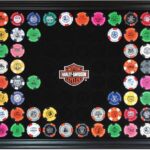I. Preparing Your Upcycled Furniture for Painting
II. Choosing the Right Paint and Tools for the Job
III. Techniques for Achieving a Professional Finish
Preparing Your Upcycled Furniture for Painting
If you’re looking to give new life to an old piece of furniture, upcycling is a fantastic way to express your creativity while being environmentally conscious. But before you dive into painting, there’s some essential prep work to ensure your project turns out beautifully. Let’s chat about getting that furniture ready for its fresh coat of paint!
1. Assessing Your Piece
Before you grab your paintbrush, take a good look at the furniture you’re planning to upcycle. Consider the following:
- Condition: Is it sturdy, or does it have loose joints? If it’s wobbly, a little repair work might be necessary before painting.
- Material: Is it wood, metal, or another material? Different surfaces may require different approaches in preparation.
- Previous Finish: Does it have old paint or a glossy finish? You might need to strip or sand it down to ensure the new paint adheres well.
2. Cleaning the Furniture
Once you’ve assessed the condition of your furniture, the next step is cleaning it thoroughly. A clean surface is crucial for a smooth finish!
- Remove Dust and Dirt: Use a damp cloth to wipe down the surface. This will remove any dust, dirt, or grease that could interfere with the paint adhesion.
- Dealing with Grime: If there are stubborn stains, a mixture of warm soapy water can work wonders. Just be sure to dry it well afterwards.
3. Repair and Prep
Now that your furniture is clean, it’s time to address any imperfections:
- Fixing Dents and Scratches: Use wood filler for any holes or scratches on wooden surfaces. Apply it, let it dry, and then sand it smooth with fine-grit sandpaper.
- Reinforce Joints: Check for any loose screws or joints. Tighten them up or use wood glue for a stronger hold.
- Sanding: Lightly sand the entire surface to create a rough texture. This helps the paint stick better! If there’s an old finish, you might need to sand it down more aggressively.
4. Priming the Surface
Depending on the type of paint you choose and the material of your furniture, priming may be a necessary step:
- Why Prime? Primer helps to seal the surface, making it easier for the paint to adhere and providing a more even finish.
- Choosing a Primer: Make sure to select a primer that’s compatible with the type of paint you’ll be using. For example, if you’re using acrylic paint, an acrylic primer is ideal.
5. Final Check
Before you start painting, do a final walkthrough:
- Ensure all repairs are dry and solid.
- Check for any dust or debris that might have settled on your freshly prepped surface.
- Gather all your supplies and make sure you’re ready to go!
With your upcycled furniture all prepped and primed, you’re now ready for the exciting part—painting! Taking the time to prepare your furniture correctly means you’ll end up with a stunning finished product that you can be proud of. Happy upcycling!
Choosing the Right Paint and Tools for the Job
So, you’ve decided to give your upcycled furniture a fresh new look! Great choice! But before you dive into the fun of painting, let’s chat about the important stuff: the right paint and tools you’ll need to achieve that stunning finish. Trust me, getting this part right will make your project so much smoother and more enjoyable.
1. Picking the Perfect Paint
First off, there are a few types of paint you’ll want to consider:
- Latex Paint: This water-based paint is super easy to work with, dries quickly, and is perfect for indoor furniture. Plus, clean-up is a breeze with just soap and water!
- Chalk Paint: If you’re after a vintage or matte finish, chalk paint is a fabulous choice. It adheres well to most surfaces and often doesn’t require a primer. Just remember to seal it afterward to protect your work.
- Milk Paint: This eco-friendly option gives a beautiful, rustic finish. It’s made from natural ingredients, so it’s safe for homes with small kids or pets. Just keep in mind that it requires a bit more prep to get it ready for application.
- Spray Paint: For small furniture pieces or intricate designs, spray paint can be a game-changer! It provides an even coating but requires a bit more precision, so practice on a scrap piece first.
When choosing paint, also consider the color and finish. Do you want something glossy that shines or a soft matte look? Test out samples on a small area of your furniture to see how the color interacts with your existing decor.
2. Essential Tools You’ll Need
Now that you’ve chosen your paint, let’s gather some tools that will make your painting experience a breeze:
- Paintbrushes: A high-quality brush is key! A good angled brush works wonders for corners and edges, while a flat brush is ideal for larger surfaces. Make sure to pick ones that are suitable for the type of paint you’re using.
- Rollers: These are great for achieving a smooth finish on larger areas. Use a roller with a nap that matches your paint for the best results.
- Sandpaper: Fine-grit sandpaper (220 grit or higher) is your best friend for smoothing surfaces before painting. If you’re using chalk paint, a bit of distressing after the first coat can add character!
- Drop Cloths: Don’t forget to protect your floors! Lay down some drop cloths or old newspapers to catch any drips or spills.
- Painter’s Tape: This is perfect for creating clean lines. Tape off any areas you don’t want to paint, such as hardware or edges.
- Sealant: If you’re using chalk or milk paint, a good sealant is necessary to protect your piece from wear and tear.
3. Getting Organized
Once you have your paint and tools ready, set up your workspace. A well-organized area will help you stay focused and make the painting process more enjoyable. Make sure you have good lighting and ventilation, and lay everything out so you can easily reach for your tools when you need them.
With the right paint and tools at your disposal, you’re now ready to transform your upcycled furniture into something truly special! Enjoy the process; painting is all about creativity and fun!
Techniques for Achieving a Professional Finish
So, you’ve prepped your furniture and chosen the perfect paint—now it’s time to dive into the fun part: painting! But how do you get that smooth, professional finish that makes your upcycled piece look like it came straight from a high-end store? Don’t worry; I’ve got some tips and techniques that will elevate your project and leave you feeling like a pro.
1. Mastering Your Brush Strokes
Your painting technique can make all the difference in the world. Here are some key points to remember:
- Use the Right Brush: A high-quality brush designed for the type of paint you’re using is crucial. For instance, use a synthetic brush for water-based paints and a natural bristle brush for oil-based paints.
- Keep it Light: When painting, use light, even strokes. Start from one edge and work your way to the other. Avoid “over-brushing,” which can leave streaks and marks.
- Feathering Techniques: As you finish a stroke, lighten your pressure and “feather” the edges. This technique helps blend and smooth the paint, reducing the appearance of brush lines.
2. The Magic of Rolling
If you’re painting a large flat surface, a foam roller can be your best friend! Here’s how to use it effectively:
- Load It Up: Dip the roller into your paint, rolling it along the tray until it’s evenly coated but not dripping.
- Roll with Purpose: Work in sections, rolling in a “W” pattern to distribute the paint evenly. Then fill in the gaps without lifting the roller too much from the surface.
- Finish with a Brush: Don’t forget to use a brush to touch up the edges and corners where the roller might not reach. This will give you that flawless look!
3. Sanding Between Coats
For a truly professional finish, don’t skip sanding! Here’s why it’s important:
- Smooths Out Imperfections: Lightly sanding between coats helps eliminate any bumps or brush strokes, giving your furniture a silky-smooth surface.
- Helps Paint Adhere: Sanding creates a better surface for the next coat of paint to adhere to, which results in a longer-lasting finish.
Just be sure to use fine-grit sandpaper and wipe down the surface with a damp cloth to remove any dust before applying additional coats.
4. Sealing the Deal
Once you’re happy with your paint job, sealing it is the cherry on top! Here are a couple of options:
- Clear Topcoat: Apply a clear sealant (like polyurethane) to protect your finish and enhance the color. Just ensure it’s compatible with the type of paint you used.
- Wax Finish: For a softer sheen, consider using wax. It adds a nice depth to the color and gives a lovely tactile quality.
And there you have it! With these techniques up your sleeve, you’re well on your way to achieving a professional-looking finish on your upcycled furniture. Remember to take your time, enjoy the process, and don’t hesitate to experiment. Happy painting!










Comments